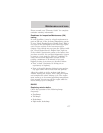
4. Subtract your initial odometer reading from the
current odometer reading.
5. Follow one of the simple calculations in order to
determine fuel economy:
Multiply liters used by 100, then divide by total
kilometers traveled.
Divide total miles traveled by total gallons
used.
Keep a record for at least one month and record the
type of driving (city or highway). This will provide
an accurate estimate of the vehicle’s fuel economy
under current driving conditions. Additionally,
keeping records during summer and winter will show
how temperature impacts fuel economy. In general,
lower temperatures give lower fuel economy.
Driving style — good driving and fuel economy
habits
Give consideration to the lists that follow and you
may be able to change a number of variables and
improve your fuel economy.
Habits
• Smooth, moderate operation can yield up to 10%
savings in fuel.
• Steady speeds without stopping will usually give
the best fuel economy.
• Idling for long periods of time (greater than one
minute) may waste fuel.
• Anticipate stopping; slowing down may eliminate
the need to stop.
• Sudden or hard accelerations may reduce fuel
economy.
• Slow down gradually.
• Driving at reasonable speeds (traveling at 88 km/h
[55 mph] uses 15% less fuel than traveling at 105
km/h [65 mph]).
Maintenance and care
173


















